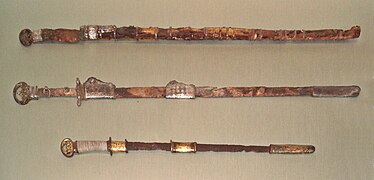Chokutō

The chokutō (直刀, "straight sword") is a straight, single-edged Japanese sword that was mainly produced prior to the 9th century. Its basic style is likely derived from similar swords of ancient China.[1][2] Chokutō were used on foot for stabbing or slashing and were worn hung from the waist.[3][2][4] Until the Heian period such swords were called tachi (大刀), which should not be confused with tachi written as 太刀 referring to curved swords.[5]
History
The production of swords in Japan is divided into specific time periods:[6]
- Jōkotō (ancient swords, until around 900 C.E.)
- Kotō (old swords from around 900–1596)
- Shintō (new swords 1596–1780)
- Shinshintō (new new swords 1781–1876)
- Gendaitō (modern or contemporary swords 1876–present)
The tsurugi was the earliest type of sword made in Japan.[7][8] The chokutō, on the other hand, was among the earliest types of sword to be forged in Japan, its basic style and forging techniques probably originated in ancient China and Korea. The chokutō was brought to Japan by way of Korean Peninsula and China in the Han dynasty times.[9][1]
There are various types of chokutō in the Kofun period (300-538), and there are styles originated in China and styles unique to Japan.[7] The kantō-tachi (環頭大刀) is a Chinese style, characterized by a ring-shaped ornament shaped like a dragon or a phoenix on the tip of the handle.[7] The Kabutsuchi-tachi (頭椎大刀) is a unique Japanese style with a fist-like decoration on the tip of the handle.[10][7] The rokkaku-sōtōken (鹿角装刀剣) is also unique to Japan and is decorated with deer antlers. As the name suggests, this style is also applied to tsurugi (ken).[11][7]
The chokutō in various styles including these styles declined around the end of the Asuka period (593-710), and only the style called the hōtō-tachi (方頭大刀), in which the decoration on the tip of the handle was rectangular parallelepiped, survived from the Nara period (710-794).[12]
Chokutō typically come in hira-zukuri and kiriha-zukuri tsukurikomi (blade styles) which make them very distinct from later tachi and katana which rarely use these forms. Swords of this period are classified as jōkotō and are often referred to in distinction from Japanese swords.[6]
Chokutō as a weapon died out by the middle of the Heian period, in the 10th century. And as a weapon, it was completely replaced by the Japanese sword, which is known today for its deep and graceful curves. The first sword with this curve was called Kenukigata-tachi (ja:毛抜形太刀), which was made by improving Warabitetō (ja:蕨手刀) used by Emishi in Tohoku region.[13][14] And Kenukigata-tachi evolved into tachi, which became the mainstream of Japanese swords for a long time.[15]
In today's Japan, straight swords made with the techniques after chokutō, are also called chokutō, and these are sometimes used in traditional ceremonies. The Sugari no Ontachi (須賀利御太刀[16]) is one of the chokutō made as an offering to Amaterasu, the main enshrined kami of Ise Grand Shrine, and one of the most gorgeous sword mountings among the chokutō. According to tradition, the building of Ise Grand Shrine and its sacred treasures have been recreated to the same specifications every 20 years since the seventh century. The Sugari no Ontachi was first described in the Kotai Jingu Gishikicho (皇太神宮儀式帳) compiled in 804, and it is believed that new decorations were added to the scabbard and sword fittings at each subsequent Shikinen Sengu (Rebuild every 20 years, 式年遷宮) to complete the design as we know it today.[17] The Sugari no Ontachi currently offered to Ise Grand Shrine was remade in 2013 and is thought to have accurately inherited the style of sword mountings from the Heian period (794ー1185) and the forging method from the Sinto period (1596-1781).[18][19][20]
Gallery
-
Shitennō-ji Shichiseiken, single-edged straight sword, Asuka period
-
Hilts of Japanese straight swords, Kofun period, 6-7th century, Met Museum.
-
Two Chinese swords (top) of the Sui dynasty. Bottom: Japanese sword with scabbard, Kofun period, 6th century, Met Museum.
-
Sword hilts, end of the Kofun period, Japan, 6th century. Musée Guimet.
See also
References
- ^ a b "Katana:The Samurai Sword",Stephen Turnbull,2010,P.16
- ^ a b The connoisseur's book of Japanese swords, Kōkan Nagayama, Kodansha International, Mar 30 1998, P.12
- ^ The Japanese sword, Kanzan Satō, Kodansha International, May 30, 1983 P.28 "Katana:The Samurai Sword",Stephen Turnbull,2010,P.16
- ^ The Japanese sword, Kanzan Satō, Kodansha International, May 30, 1983 P.28
- ^ "太刀・大刀". Daijirin at kotobank.jp (in Japanese). Retrieved July 22, 2015.
- ^ a b Transition of kotō, shintō, shinshintō, and gendaitō. Nagoya Japanese Sword Museum Touken World
- ^ a b c d e Kazuhiko Inada (2020), Encyclopedia of the Japanese Swords. p30. ISBN 978-4651200408
- ^ 特別展「出雲-聖地の至宝-」展に荒神谷遺跡出土の銅剣がずらり. Tokyo National Museum
- ^ "The Craft of the Japanese Sword",Leon Kapp,1987,P.20
- ^ Kabutsuchi-tachi. Kotobank.
- ^ Rokkaku-sōtōken. Kotobank.
- ^ Kazuo Ichise (October 1996). 金の大刀と銀の大刀-古墳・飛鳥時代の貴族と階層-平成8年度秋季特別展大阪府立近つ飛鳥博物館図録 9 二 大刀外装の変化. Osaka Prefectural Chikatsu Asuka Museum. pp. 74–83.
- ^ Shimomukai, Tatsuhiko (30 June 2000). The Review of the Study of History : Shigaku Kenkyu. 広島史学研究会.
- ^ John T. Kuehn (15 January 2014). A Military History of Japan: From the Age of the Samurai to the 21st Century. Praeger. p. 34. ISBN 978-1-59228-720-8.
- ^ 歴史人 September 2020. p.6 pp.36-37. ASIN B08DGRWN98
- ^ Not 大刀, but 太刀
- ^ 須賀利御太刀 写し (A replica of the Sugari no Ontachi). Nagoya Japanese sword Museum Nagoya Touken World
- ^ 伊勢神宮の神宝 御太刀 ―宝刀の魅力― 神宮の博物館 Jingu Museum official site.
Note:The photo on the site shows Tamamaki no Ontachi. - ^ 美を継ぐ神宝―伊勢の神宮 御装束神宝調製. p.2. 家庭画報
- ^ モノづくり再生は新旧技術のコラボレーションで. p.3. 旭化成

![Shitennō-ji Shichiseiken [ja], single-edged straight sword, Asuka period](http://upload.wikimedia.org/wikipedia/commons/thumb/6/6c/Seven_stars_sword_Sitenoji_rotated.jpg/552px-Seven_stars_sword_Sitenoji_rotated.jpg)


